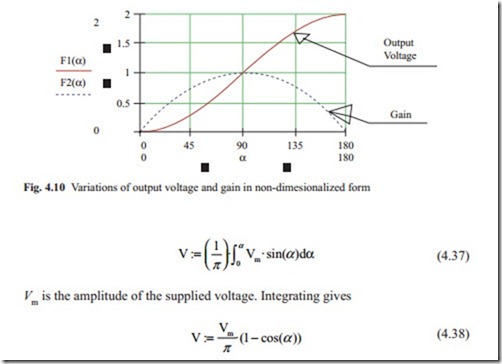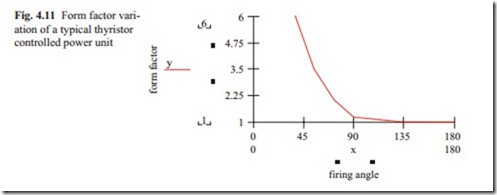Properties of Power Unit
In the previous section, various forms of power unit for DC servo motors were discussed. It is important to understand the relationship between the output voltage and the control signal. In Sect. 4.6, a single gain K was used to transfer the control signal to a high current and voltage were used. In actual system, a series of rectified pulses are connected to the motor. The motor then responds to the average output voltage. The purpose of this section is to study the relationship between the control signal and the output voltage and to high-light important properties of power unit. First thyristor controlled power unit will be discussed.
It was shown in Fig. 4.2 that the low level control signal controls the firing angle of thyristor. A portion of the input signal over one period will pass through the thyristor. The worst condition when single-phase half rectification is used will be considered here. Generally the firing angle is proportional to the control signal as
where α is the firing angle, Kc is the transformation gain, and Vc is the control signal. The average output voltage may be obtained as
It can be seen that the relationship between the voltage supplied to the motor and the firing angle is nonlinear. Therefore, the gain depends on the firing angle. The gain is obtained by differentiating the voltage with respect to the firing angle, which gives
The above diagram shows that the gain is zero at 0 and 180° firing angle and it is maximum at 90° firing angle. In the previous analysis the overall gain was considered. This diagram shows that for stability the maximum gain must be considered and for studying the accuracy the minimum gain must be considered. To prevent
zero gain, the manufacturers usually design thyristor controlled power units so that around the zero firing angle thyristors are fired in both directions. This will provide some stiffness against the external torque. For analysis of stiffness, the gain at about 5–10° firing angles must be considered.
Another important property of a thyristor controlled power unit is the power loss in motors. Assuming a resistive load quantity is known, form factor must be considered. This shows the power loss in motors. The power loss is proportional to square of Irms and the power applied to the motor is proportional to Iave. The ratio of
two currents is known as form factor.
![]() Without the detailed calculations, the form factor for a single-phase half wave rec- tification is shown in Fig. 4.11.
Without the detailed calculations, the form factor for a single-phase half wave rec- tification is shown in Fig. 4.11.
Figure 4.11 shows that the power loss at small firing angle is very large and it reduces as firing angle is increased.
For Pulse Width Modulated power unit the output voltage is proportional to the mark space ratio. In this case, the gain is constant and the form factor is one.


